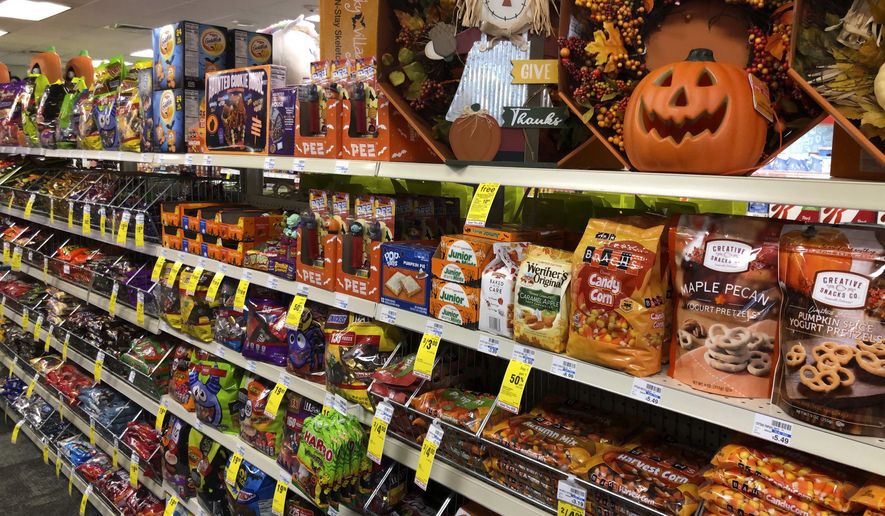Costume sellers and candy merchants anticipate record-high revenue this Halloween, even as tariffs and rising chocolate costs bedevil inflation-weary consumers.
The National Retail Federation projects that U.S. spending on Halloween will surge to a record high $13.1 billion this year, up from $11.6 billion last year and the previous peak of $12.2 billion recorded in 2023.
That includes expected increases in consumer splurges on candy, decorations, costumes and greeting cards, as spending per person jumps by nearly $11 to $114.45.
“The National Retail Federation sees roughly 3 in 4 Americans celebrating again this year, which tells me the holiday has real cultural staying power even as prices bite,” said Angelica Gianchandani, a marketing instructor at New York University.
Industry insiders interviewed by The Washington Times said revenue is up because of tariff-driven inflation, higher cocoa prices and the fact that the holiday falls on a Friday this year. Traditionally, Halloween sales revenue is highest when the holiday falls during a weekend.
The Halloween & Costume Association estimates that Trump administration tariffs have increased the price of a bargain-basement children’s witch or ghost costume from $19.99 last year to $39.99 this year.
Simple goblin masks priced at $4.99 a year ago now cost $9.99 or more, according to the trade group, which represents more than 30 retailers and manufacturers.
“Due to ongoing tariffs, the cost of Halloween products has risen significantly compared to previous years,” Michele Boylstein, the Halloween & Costume Association’s executive director, said in an email. “These tariffs cannot be fully absorbed by manufacturers or retailers, resulting in some of the increased costs being passed on to consumers.”
She noted that most plastics and textiles for decorations and costumes come from China. The White House imposed heavy duties on importers of Chinese goods just as they received shipments for Halloween.
Ms. Boylstein said one of her importers paid $250,000 to unload a $100,000 shipment shortly after taxes on Chinese imports surged in April.
The National Confectioners Association, a candy industry trade group, estimates that revenue for chocolate and sweets will climb by 3% from $7.4 billion last year. That’s up from a 2.2% increase from 2023 to 2024.
The confectionery industry, which generates $54 billion in annual sales, expects revenue to reach $70 billion by 2029. Roughly 18% of last year’s profit came from Halloween treats.
“Even as consumers face higher prices for food, they continue to leave room in their budgets for chocolate and candy, meaning that the category is strong, vibrant and growing,” said Carly Schildhaus, a spokesperson for the association.
At least part of the industry’s growing profit comes from pandemic inflation. Sugar and cocoa prices have surged in recent years because of bad weather patterns for crops and rising labor, manufacturing and shipping costs.
“I know chocolate generally is way up, so any Halloween candy with chocolate will definitely be more expensive,” said Edgar Dworsky, founder of the website Consumer World, which has tracked inflation in consumer food prices since 1995.
Discounts and dollar stores
Reports suggest price increases could limit Halloween spending in some categories this year.
Online financial services company Lending Tree reported this month that more than 60% of 2,000 shoppers responding to a recent survey said they planned to skip specific purchases because of shrinking budgets. They named candy and decorations as their top planned cuts.
“When budgets are tight and prices are rising, people tend to adjust their spending to focus on their priorities,” Matt Schulz, Lending Tree’s chief consumer financial expert, said in an email.
In a separate survey of 2,093 adults that the Harris Poll conducted for CIT Bank, 57% of respondents said they planned to buy candy in bulk, and 49% said they would shop at discount and dollar stores.
The survey, released this month, showed that 38% of adults planned to make their own Halloween costumes and 28% expected to reuse older costumes to save money.
“This significant focus on budget-conscious behavior suggests that consumers are adapting to perceived or actual cost increases,” Latoya Welch, a Harris Poll vice president, said in an email.
Economists say retailers have offered Halloween products and discounts earlier than usual this year to woo inflation-wary consumers and offset the financial uncertainty surrounding tariffs.
“It does not appear fewer people will celebrate Halloween this year, but I do hear consumers being more concerned about cost in general,” said Tom Arnold, a finance professor at the University of Richmond. “The retailers are also willing to discount items earlier.”
The White House defended the president’s tariff agenda in a Wednesday email.
“Real prosperity is good jobs, booming industry, and thriving communities for everyday Americans — not cheap Chinese imports,” White House spokesman Kush Desai said. “President Trump pledged to use tariffs to level the playing field, address fentanyl smuggling, and restore American Greatness. Rising real wages, historic trade deals, and trillions in investment commitments to make and hire in America prove that President Trump’s America First agenda is paying off for the American people in the ways that matter most.”
Will Hild, executive director of the right-leaning advocacy group Consumers’ Research, credited Mr. Trump’s fiscal policies for driving up Halloween spending after it dropped by $600 million under the Biden administration last year.
“President Biden’s reckless spending sent prices soaring and caused crushing inflation, which forced many hardworking Americans to cut back on family activities like Halloween,” Mr. Hild said in an email. “Now, thanks to President Trump’s ‘America First’ economic policies, inflation is finally decreasing, wages are rising and families are beginning to feel relief.”
• Sean Salai can be reached at ssalai@washingtontimes.com.




Please read our comment policy before commenting.